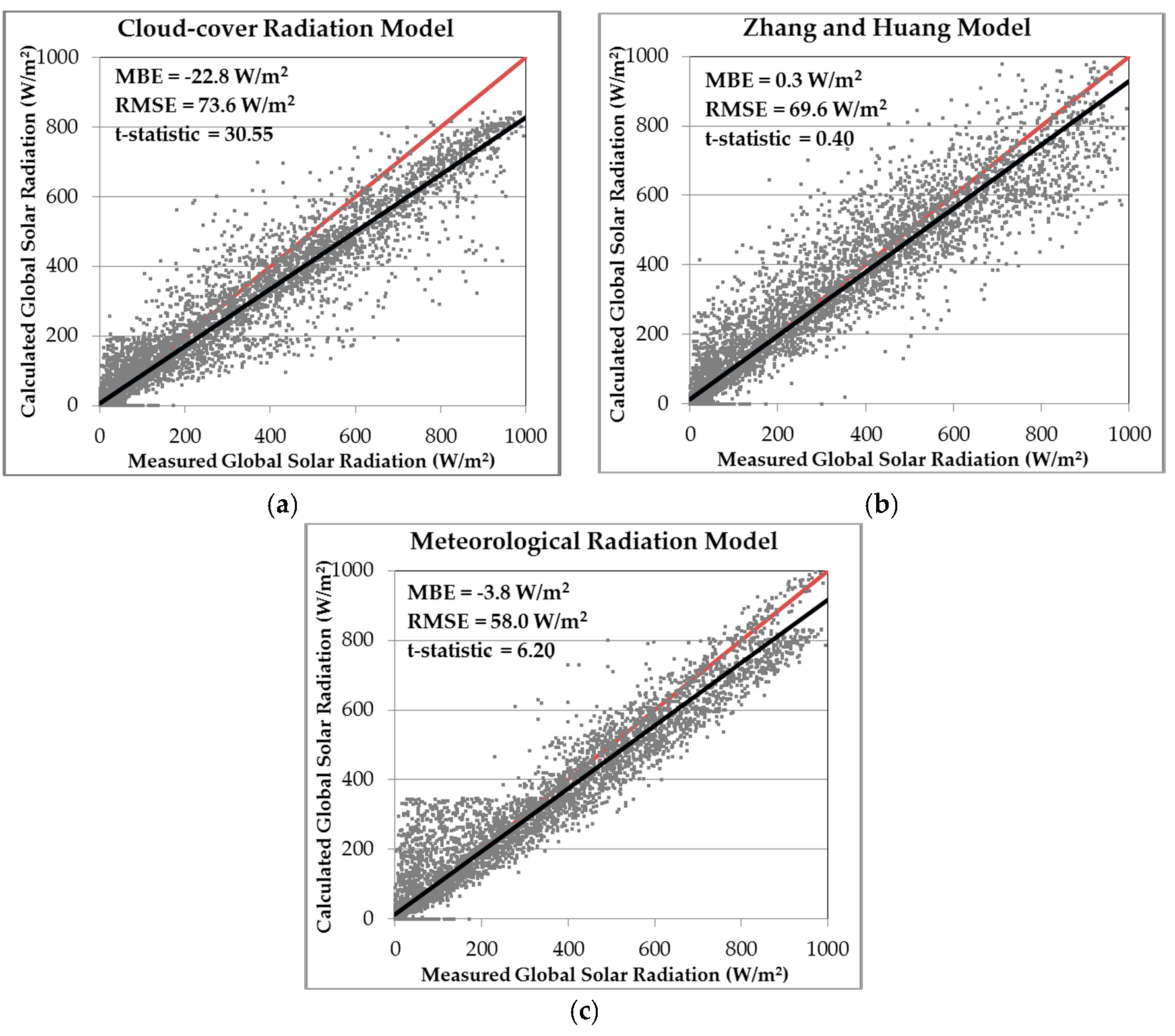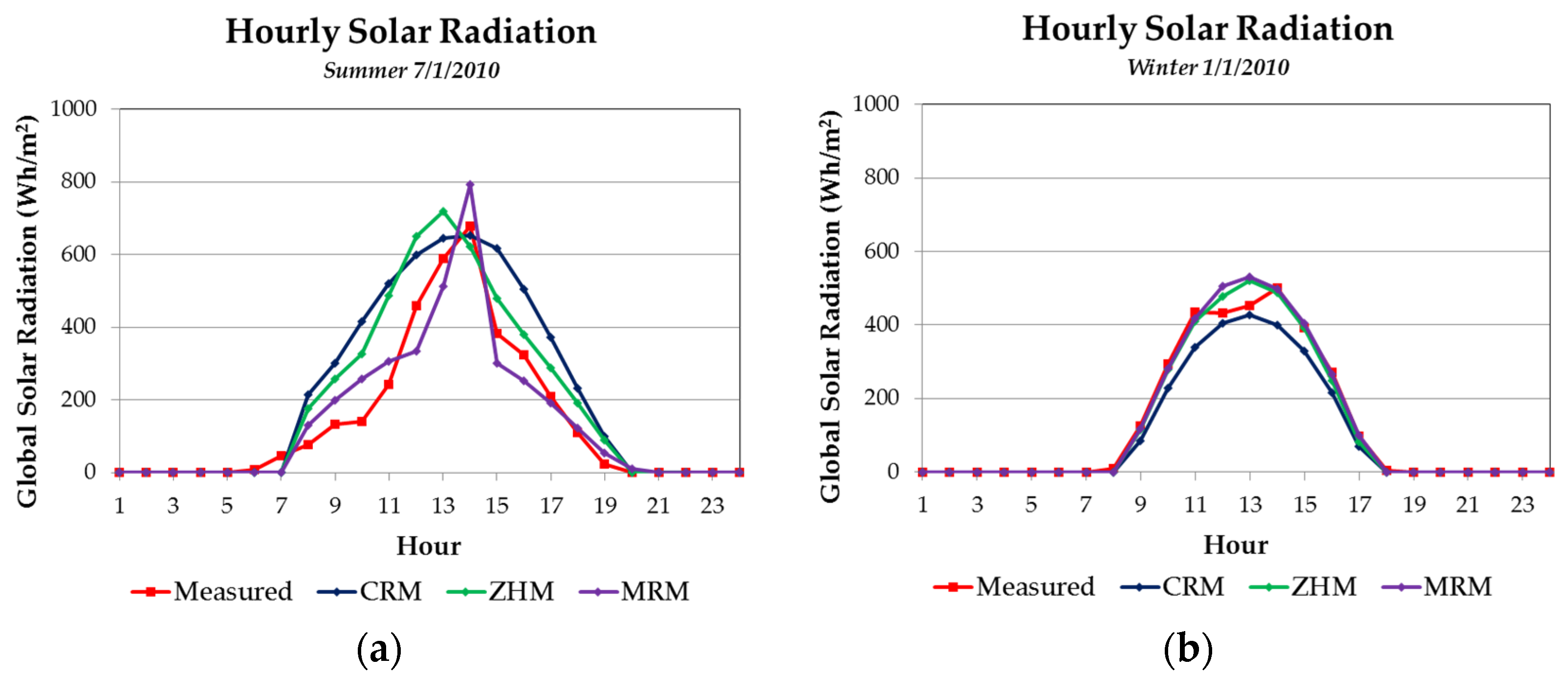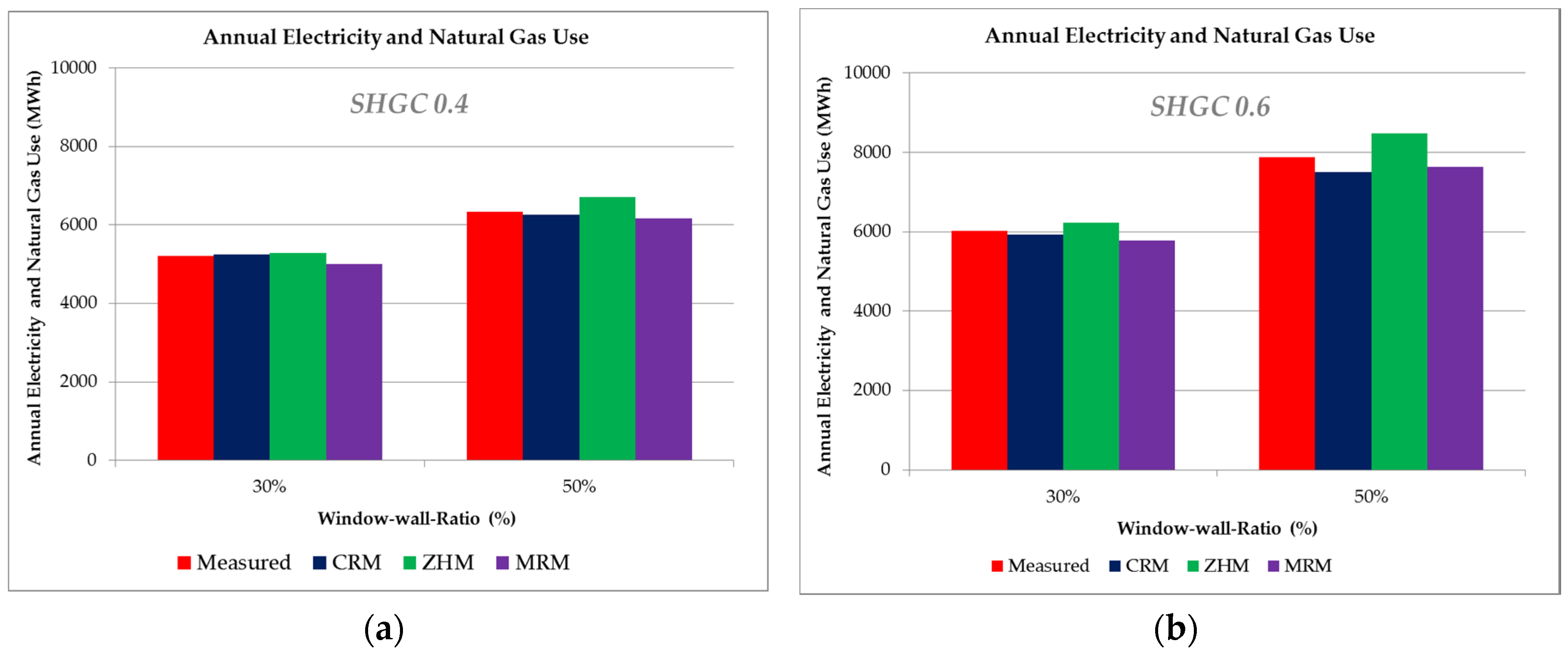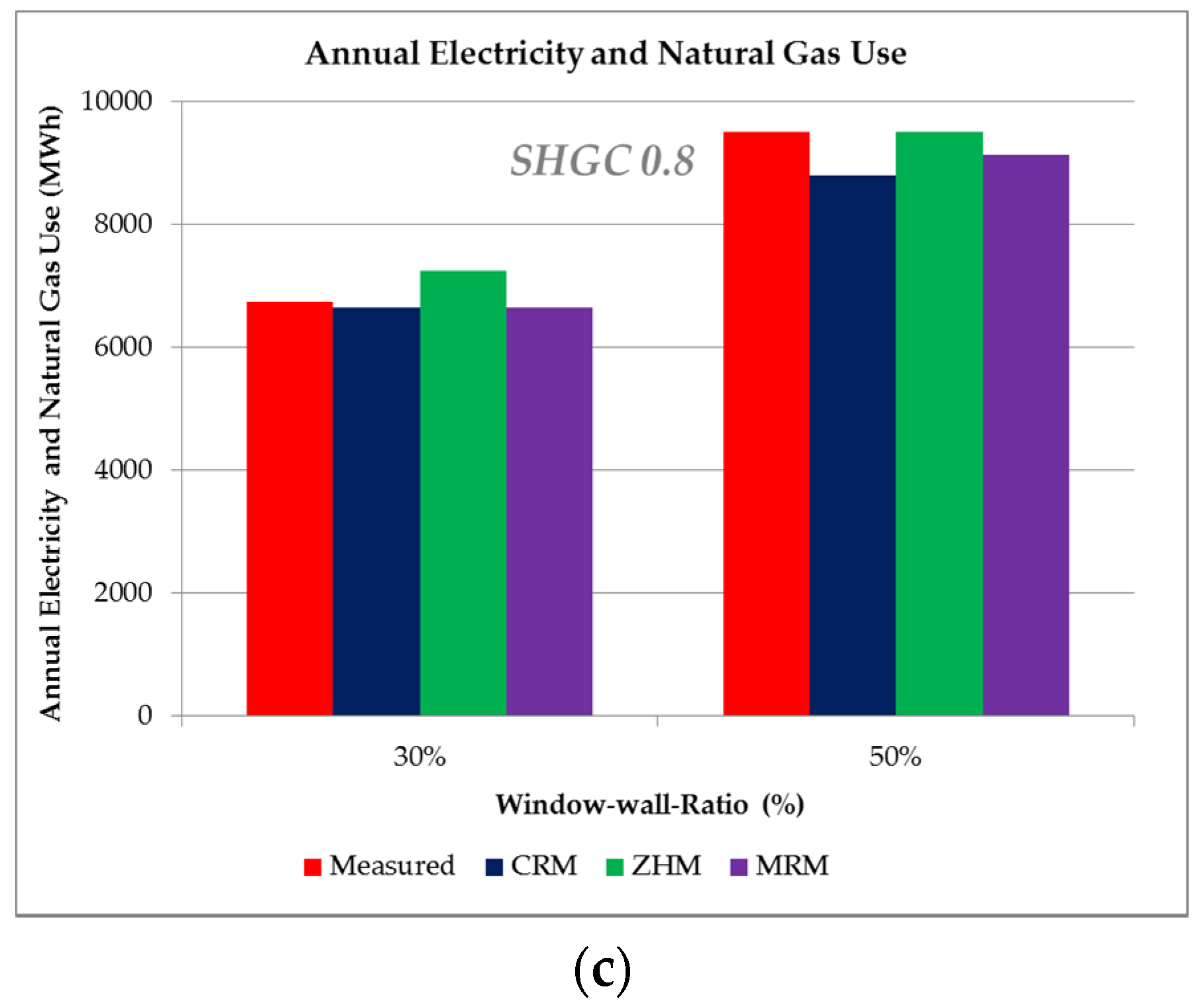Study on Solar Radiation Models in South Korea for Improving Office Building Energy Performance Analysis
Abstract
:1. Introduction
2. Results
2.1. Global Solar Radiation Models
2.1.1. Cloud-Cover Radiation Model (CRM)
2.1.2. Zhang and Huang Model (ZHM)
2.1.3. Meteorological Radiation Model (MRM)
2.2. Global Solar Radiation Results Obtained Using the Three Solar Models
2.3. An Office Building’s Energy Performance using Calculated Solar Models
2.3.1. Actual Meteorological Year (AMY) Weather File
- (1)
- Weather parameters
- (2)
- Packing Actual Meteorological Year (AMY) weather files
2.3.2. Analysis of an Office Building’s Energy Performance
- (1)
- Building Energy Simulation Program
- (2)
- Results of the Building Energy Performance Analysis
3. Discussion and Conclusions
- (1)
- The hourly global solar radiation in Busan, South Korea in 2010 was calculated using three different solar models (i.e., CRM, ZHM, and MRM) and compared to the measured solar radiation. As a result, ZHM was selected as the most accurate model in this area, generally, but it showed significant differences from the measured data in extreme seasonal conditions, such as those that occur in summer and winter. Thus, the model should be improved by considering seasonal characteristics, which could be accomplished by using additional weather parameters, such as sunshine duration, atmospheric pressure, and so on (similar to those that were used in MRM).
- (2)
- In the office building energy performance, when the effect of global solar radiation was small (i.e., when the building had low SHGC and WWR), the differences in energy consumption between using the measured solar radiation and the solar radiation calculated from the solar models were small, ranging from −0.6% to 4%, but the differences increased up to 8% as the SHGC and WWR increased.
- (3)
- The most accurate solar models (according to changes in the SHGC and WWR) were as follows: CRM and ZHM were shown to be the most accurate if the office building had low SHGC and WWR (i.e., 0.4 and 30%, respectively), and MRM was the most accurate in high SHGC and WWR (i.e., 0.8 and 50%, respectively).
- (4)
- Variations in the building energy simulation results could be caused by the weather parameters used in the solar models. CRM calculates global solar radiation using only one weather parameter, cloud amount, but MRM uses sunshine duration, dry- and wet-bulb temperatures, atmospheric pressure, and cloud amount to determine the influence of the absorption and scattering of the solar radiation in the atmosphere.
- (5)
- The analysis results imply the necessity of the following considerations when performing a building energy analysis using calculated solar radiation: it is important to predict solar radiation to have a closer tendency on an hourly basis to the measured solar radiation when applying it to building energy simulation programs, although more case studies should be considered in the future work, including varying other window characteristics, such as U-value and visible transmittance, etc., and other building envelope characteristics. In addition, to improve building energy performance analyses, the accuracy of calculated solar radiation should be improved through the consideration of seasonal characteristics. Therefore, a new solar model for South Korea that applies the findings from this study should be developed; it will improve future building energy performance analyses.
Acknowledgments
Author Contributions
Conflicts of Interest
Abbreviations
| Im | Measured Hourly Global Solar Radiation (W/m2) |
| Io | Solar Constant (1366 W/m2) |
| Ie | Extraterrestrial Solar Radiation (W/m2) |
| Ig | Calculated Hourly Global Solar Radiation (W/m2) |
| Ib | Calculated Hourly Direct Solar Radiation (W/m2) |
| Id | Calculated Hourly Diffuse Solar Radiation (W/m2) |
| Ids | Circumsolar Diffuse Radiation by a Single-scattering Mode of Molecules and Aerosols (W/m2) |
| Idm | Diffuse Radiation Reflected by the Ground and Backscattered by the Atmosphere (W/m2) |
| Ig-c | Calculated Hourly Global Solar Radiation for a clear sky (W/m2) |
| Ib-c | Calculated Hourly Direct Solar Radiation for a clear sky (W/m2) |
| Id-c | Calculated Hourly Diffuse Solar Radiation for clear sky (W/m2) |
| α | Solar Altitude Angle (m) |
| θz | Zenith Angle (degree) |
| N | Cloud Amount (0–10 okta) |
| n | Number of Data Points |
| Φ | Relative Humidity (%) |
| Tn, Tn-3 | Dry-bulb Temperature in Celsius at hours n and (n-3), respectively |
| Vw | Wind Speed (m/s) |
| τ | Optical Transmittance |
| αg, αs | Albedo of the Surface and the Clear Sky |
References
- Korea Meteorological Administration. Available online: http://www.kma.go.kr/index.jsp (accessed on 13 June 2010).
- Lee, K.; Sim, K. Analysis and calculation of global hourly solar irradiation based on sunshine duration for major cities in Korea. J. Korean Sol. Energy Soc. 2010, 30, 16–21. (In Korean) [Google Scholar]
- Kasten, F.; Czeplak, G. Solar and terrestrial radiation dependent on the amount and type of cloud. Sol. Energy 1980, 24, 177–189. [Google Scholar] [CrossRef]
- Zhang, Q.; Huang, Y. Development of typical year weather files for Chinese locations. ASHRAE Trans. 2002, 108, 1063–1075. [Google Scholar]
- Kambezidis, H.; Psiloglou, B. The Meteorological Radiation Model (MRM): Advancements and Applications. In Modeling Solar Radiation at the Earth’s Surface; Springer: Berlin, Germany, 2008. [Google Scholar]
- Yang, K.; Koike, T. Estimating surface solar radiation from upper-air humidity. Sol. Energy 2002, 77, 177–186. [Google Scholar] [CrossRef]
- Perez, R.; Ineichen, K.; Moore, K.; Kmiecik, M.; Chain, C.; George, R.; Vignola, F. A new operational model for satellite-derived irradiances: description and validation. Sol. Energy 2002, 73, 307–317. [Google Scholar] [CrossRef]
- Perez, R.; Moore, M.; Wilcox, S.; Renne, D.; Zelenka, K. Forecasting solar radiation: preliminary evaluation of an approach based upon the National Forecast Database. Sol. Energy 2007, 81, 809–812. [Google Scholar] [CrossRef]
- Zelenka, A.; Perez, R.; Seals, R.; Renne, D. Effective accuracy of the satellite-derived hourly irradiance. Theor. Appl. Climatol. 1999, 62, 199–207. [Google Scholar]
- HelioClim. HelioClim: Providing Information on Solar Radiation; Centre Energetique et Procedes of Ecole des Miners de Paris. Available online: http://www.helioclim.org/heliosat/index.html (accessed on 19 June 2016).
- Janjai, S.; Laksanaboonsong, J.; Nunez, M.; Thongsathitya, A. Development of a method for generating operational solar radiation maps from satellite data for a tropical environment. Sol. Energy 2005, 78, 739–751. [Google Scholar] [CrossRef]
- Krarti, M.; Hunag, J.; Seo, D.; Dark, J. Development of Solar Radiation Models for Tropical Locations, ASHRAE Project RP-1309; ASHRAE: Atlanta, GA, USA, 2006. [Google Scholar]
- Seo, D.; Krarti, M. Impact of solar models on building energy analysis for tropical sites. ASHRAE Trans. 2007, 113, 523–530. [Google Scholar]
- Wan, K.; Cheung, K.; Liu, D.; Lam, J.C. Impact of modelled global solar radiation on simulated building heating and cooling loads. Energy Convers. Manag. 2009, 50, 662–667. [Google Scholar] [CrossRef]
- Gul, M.; Muneer, T.; Kambezidis, H. Models for obtaining solar radiation from other meteorological data. Sol. Energy 1998, 64, 99–108. [Google Scholar] [CrossRef]
- Muneer, T.; Gul, M. Evaluation of sunshine and cloud cover based models for generating solar radiation data. Energy Convers. Manag. 2000, 41, 461–482. [Google Scholar] [CrossRef]
- Yoo, H.; Lee, K.; Park, S. Analysis of data and calculation of global solar radiation based on cloud data for major cities in Korea. J. Korean Sol. Energy Soc. 2008, 28, 17–24. (In Korean) [Google Scholar]
- Psiloglou, B.; Kambezidis, H. Performance of the meteorological radiation model during the solar eclipse of 29 of March 2006. Atmos. Chem. Phys. Discuss. 2007, 7, 6047–6059. [Google Scholar] [CrossRef]
- Stone, R. Improved statistical procedure for the evaluation of solar radiation estimation models. Sol. Energy 1993, 51, 289–291. [Google Scholar] [CrossRef]
- Duffie, J.; Beckman, W. Solar Engineering of Thermal Processes, 2nd ed.; John Wiley & Sons, Inc.: Hoboken, NJ, USA, 2006. [Google Scholar]
- Buhl, F. Weather Processor; Lawrence Berkeley National Laboratory: Berkeley, CA, USA, 1999. [Google Scholar]
- LBNL. DOE-2.2 Building Energy Use and Cost Analysis Program, Volume 1: Basics; Lawrence Berkeley National Laboratory: Berkeley, CA, USA, 2004. [Google Scholar]
- ASHRAE. ASHRAE Standard 90.1–2007; American Society of Heating, Refrigeration, and Air-Conditioning Engineers: Atlanta, GA, USA, 2007. [Google Scholar]
- Korea Energy Agency. Design Standard Guideline for Building Energy Saving; Korea Energy Agency: Gyeonggi-do, Korea, 2011. (In Korean) [Google Scholar]
- Gowri, K.; Winiarski, D.; Jarnagin, R. Infiltration Modeling Guidelines for Commercial Building Energy Analysis, PNNL-18898; Pacific Northwest National Laboratory: Washington, DC, USA, 2009. [Google Scholar]
- Deru, M. Energy Savings Modeling and Inspection Guidelines for Commercial Building Federal Tax Deductions; National Renewable Energy Laboratory: Golden, CO, USA, 2007. [Google Scholar]





| Model | Jan. | Feb. | Mar. | Apr. | May | Jun. | Jul. | Aug. | Sept. | Oct. | Nov. | Dec. | Ann. |
|---|---|---|---|---|---|---|---|---|---|---|---|---|---|
| CRM | 2.51 | 1.82 | 1.31 | 1.85 | 1.50 | 1.58 | 1.40 | 1.80 | 2.02 | 2.53 | 2.54 | 2.10 | 6.23 |
| ZHM | 0.99 | 1.05 | 1.64 | 0.96 | 0.02 | 0.46 | 0.94 | 1.71 | 1.21 | 0.57 | 0.72 | 1.10 | 0.08 |
| MRM | 0.98 | 0.35 | 1.01 | 0.24 | 0.10 | 0.38 | 0.60 | 0.99 | 0.88 | 1.83 | 1.06 | 0.22 | 1.26 |
| Weather Parameters | Weather | Weather | Weather | Weather |
|---|---|---|---|---|
| File #1 | File #2 | File #3 | File #4 | |
| Dry-bulb Temperature | Weather Sta. | Weather Sta. | Weather Sta. | Weather Sta. |
| Wet-bulb Temperature | Weather Sta. | Weather Sta. | Weather Sta. | Weather Sta. |
| Dew-point Temperature | Weather Sta. | Weather Sta. | Weather Sta. | Weather Sta. |
| Wind Speed | Weather Sta. | Weather Sta. | Weather Sta. | Weather Sta. |
| Wind Direction | Weather Sta. | Weather Sta. | Weather Sta. | Weather Sta. |
| Atmospheric Pressure | Weather Sta. | Weather Sta. | Weather Sta. | Weather Sta. |
| Global Solar Radiation | Measured | CRM | ZHM | MRM |
| Direct Normal Solar Radiation | Calculated by Erbs using measured | Calculated by Erbs using measured | Calculated by Erbs using measured | Calculated by Erbs using measured |
| Category | Input | Value |
|---|---|---|
| General | Floor area (m2) | 2323 |
| Number of floors | 10 | |
| Window-to-wall ratio (%) | 28 | |
| Floor-to-ceiling height (m) | 2.7 | |
| Exterior wall | U-factor (W/m2·K) | 0.45 |
| Roof | U-factor (W/m2·K) | 0.24 |
| Slab-on-grade floor | U-factor (W/m2·K) | 0.58 |
| Window/Door | U-factor (W/m2·K) | 2.70 |
| Solar Heat Gain Coefficient | 0.40 | |
| Air infiltration (m3/hr·m2) | 2.19 | |
| Internal load | Area/Person (m2) | 9.3 |
| People load (W) | 117.2 | |
| Lighting density (W/m2) | 12.92 | |
| Equipment density (W/m2) | 16.15 | |
| System | Type | Input and value |
|---|---|---|
| HVAC | - | SD VAV w/reheat |
| Plant | Chiller efficiency | SEER 13 |
| Boiler efficiency (%) | 86.5% | |
| Service water heater efficiency | EF 0.93 |
| SHGC | Model | Jan. | Feb. | Mar. | Apr. | May | Jun. | Jul. | Aug. | Sep. | Oct. | Nov. | Dec. | Ann. |
|---|---|---|---|---|---|---|---|---|---|---|---|---|---|---|
| 0.4 | CRM | 1.8 | 1.6 | 2.2 | 1.0 | −0.6 | 0.3 | −0.4 | −0.8 | 1.0 | −0.4 | 1.3 | 1.3 | 0.6 |
| ZHM | 0.9 | 0.2 | 0.4 | 0.9 | 0.2 | 2.9 | 3.0 | 2.0 | 2.4 | 1.7 | 1.8 | 0.7 | 1.5 | |
| MRM | −3.7 | −4.4 | −3.9 | −4.8 | −5.5 | −4.1 | −2.8 | −3.1 | −3.3 | −4.7 | −5.1 | −4.6 | −4.0 | |
| 0.6 | CRM | 1.6 | −0.4 | 0.2 | −1.3 | −3.3 | −2.4 | −3.5 | −3.8 | −1.3 | −2.3 | −0.9 | −0.5 | −1.6 |
| ZHM | 3.0 | 2.1 | 1.9 | 2.4 | 1.6 | 4.9 | 3.9 | 3.1 | 4.5 | 4.5 | 3.6 | 2.6 | 3.3 | |
| MRM | −4.0 | −4.5 | −4.5 | −4.9 | −5.4 | −3.5 | −3.6 | −3.1 | −2.9 | −3.4 | −4.9 | −4.8 | −4.0 | |
| 0.8 | CRM | 1.6 | −1.0 | 0.2 | −1.0 | −2.8 | −2.0 | −3.3 | −3.3 | −0.7 | −1.6 | −0.6 | −0.3 | −1.4 |
| ZHM | 6.4 | 4.6 | 5.1 | 5.8 | 5.3 | 8.8 | 7.8 | 6.8 | 8.7 | 8.7 | 7.2 | 6.0 | 6.9 | |
| MRM | −2.8 | −3.4 | −2.8 | −2.8 | −2.7 | −0.5 | −0.6 | −0.5 | 0.3 | −0.3 | −2.5 | −3.2 | −1.6 |
| SHGC | Model | Jan. | Feb. | Mar. | Apr. | May | Jun. | Jul. | Aug. | Sep. | Oct. | Nov. | Dec. | Ann. |
|---|---|---|---|---|---|---|---|---|---|---|---|---|---|---|
| 0.4 | CRM | 1.7 | 0.0 | 0.4 | −1.0 | −2.7 | −2.2 | −3.5 | −3.8 | −1.1 | −1.7 | −0.1 | −0.4 | −1.3 |
| ZHM | 4.6 | 4.2 | 3.9 | 4.6 | 4.3 | 7.4 | 6.4 | 5.2 | 7.1 | 7.4 | 6.3 | 4.6 | 5.6 | |
| MRM | −3.2 | −3.4 | −3.2 | −3.6 | −3.7 | −1.9 | −2.1 | −2.4 | −1.4 | −1.5 | −3.3 | −3.6 | −2.7 | |
| 0.6 | CRM | −1.6 | −4.2 | −3.1 | −4.8 | −6.6 | −6.4 | −7.7 | −7.5 | −5.0 | −5.2 | −3.6 | −3.4 | −5.2 |
| ZHM | 6.7 | 4.8 | 5.1 | 5.6 | 5.4 | 8.7 | 7.8 | 6.9 | 8.6 | 9.2 | 7.5 | 6.2 | 7.0 | |
| MRM | −4.3 | −4.9 | −4.6 | −4.8 | −4.6 | −2.4 | −2.4 | −2.0 | −1.6 | −1.6 | −3.9 | −4.7 | −3.3 | |
| 0.8 | CRM | −4.2 | −7.5 | −5.8 | −7.7 | −9.5 | 9.4 | −11.0 | −11.0 | −8.1 | −7.9 | −6.3 | −6.2 | −8.1 |
| ZHM | 6.6 | 4.4 | 5.2 | 5.9 | 5.8 | 9.2 | 8.1 | 7.1 | 8.8 | 9.9 | 7.9 | 6.3 | 7.3 | |
| MRM | −5.5 | −6.1 | −5.7 | −5.8 | −5.4 | −3.1 | −3.0 | −2.3 | −2.3 | −2.1 | −4.8 | −5.6 | −4.0 |
© 2016 by the authors; licensee MDPI, Basel, Switzerland. This article is an open access article distributed under the terms and conditions of the Creative Commons Attribution (CC-BY) license (http://creativecommons.org/licenses/by/4.0/).
Share and Cite
Kim, K.H.; Oh, J.K.-W.; Jeong, W. Study on Solar Radiation Models in South Korea for Improving Office Building Energy Performance Analysis. Sustainability 2016, 8, 589. https://doi.org/10.3390/su8060589
Kim KH, Oh JK-W, Jeong W. Study on Solar Radiation Models in South Korea for Improving Office Building Energy Performance Analysis. Sustainability. 2016; 8(6):589. https://doi.org/10.3390/su8060589
Chicago/Turabian StyleKim, Kee Han, John Kie-Whan Oh, and WoonSeong Jeong. 2016. "Study on Solar Radiation Models in South Korea for Improving Office Building Energy Performance Analysis" Sustainability 8, no. 6: 589. https://doi.org/10.3390/su8060589
APA StyleKim, K. H., Oh, J. K.-W., & Jeong, W. (2016). Study on Solar Radiation Models in South Korea for Improving Office Building Energy Performance Analysis. Sustainability, 8(6), 589. https://doi.org/10.3390/su8060589





